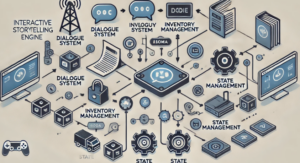Crafting Complex Storytelling Engines for Interactive Novels and Games

Learn how to build complex storytelling engines for interactive novels or games with this comprehensive step-by-step guide, designed for developers and writers.
The Art of Storytelling in Interactive Media
Interactive novels and games are rapidly gaining popularity as a dynamic form of entertainment. These projects rely heavily on strong storytelling engines to provide a compelling narrative that adapts to player choices. A storytelling engine powers the branching paths, choices, and character development, ensuring that each player’s journey is unique. In this guide, a detailed step-by-step approach will be provided on how to build these complex storytelling engines, tailored to both narrative-driven video games and interactive novels.
Creating a storytelling engine requires a deep understanding of narrative structure, programming, and player interaction. The complexity arises from designing an engine that allows for decision-making while maintaining narrative coherence. This article will guide you through each stage, from the initial planning stages to implementing the engine, ensuring your interactive story is both engaging and functional.
Understanding Storytelling Engines
What is a Storytelling Engine?
A storytelling engine is the core framework that drives interactive narratives. It is responsible for managing how the story evolves based on the choices the player makes. This engine is composed of several key components:
- Choice Management: Determines how player decisions affect the narrative.
- State Tracking: Tracks variables like character relationships, plot progression, and world status.
- Branching Paths: Allows for multiple narrative routes, creating a dynamic experience for players.
- Dialogue and Event Triggers: Implements dynamic dialogue systems and events triggered by specific conditions.
A strong storytelling engine offers the flexibility to deliver a personalized experience without sacrificing the integrity of the narrative.
Key Principles of Building a Storytelling Engine
To create an effective engine, it is crucial to understand the principles that guide interactive storytelling:
- Branching Narrative: The narrative must have diverging paths that provide meaningful choices to the player.
- Character Progression: Characters should evolve based on the player’s decisions, making each interaction meaningful.
- Immersive World-Building: The engine should create a world that reacts logically to player actions.
- Consistency: The engine should maintain consistency, ensuring that changes made by the player do not contradict previously established elements.
Tools and Technologies for Building a Storytelling Engine
Choosing the Right Tools
The tools and technologies chosen will largely depend on the platform and the complexity of the story. Several software tools and frameworks can help streamline the process:
- Twine: A popular tool for creating branching stories with minimal programming knowledge. It’s particularly useful for text-based interactive novels.
- Ren’Py: A visual novel engine designed for creating interactive stories with visual and audio elements.
- Ink: A narrative scripting language by Inkle Studios, used to create complex interactive stories with a lightweight syntax.
- Unity: A more advanced engine often used for games. It can be paired with narrative tools like Yarn Spinner to create branching narratives.
Core Technologies for Implementation
When deciding on the backend infrastructure, several components should be considered:
- Scripting Languages: Python, C#, or JavaScript are commonly used for scripting choices and event systems.
- Databases: A database management system (DBMS) may be necessary for tracking player choices and storing large narrative trees.
- State Management: Variables such as flags, counters, and inventories need to be carefully managed to ensure continuity.
For a deeper dive into these tools, a dedicated table highlighting the key features and benefits of each will be provided later in this article.
Designing Branching Narrative Systems
Planning Branches and Choices
The foundation of any interactive story lies in its branching narrative. The primary challenge is to design a system where player choices feel impactful, but also maintain narrative cohesion. A good starting point is to create a flowchart that visualizes all potential narrative branches.
This flowchart serves as the skeleton of your storytelling engine. As decisions are made, the flowchart branches into different outcomes. Each branch can lead to new choices, dialogue, and consequences, which the engine must track.
- Linear: The narrative progresses along a single path without diverging.
- Branching: The narrative splits into two or more directions based on player choices.
- Converging: Multiple branches may eventually reconvene at the same point.
To maintain a clean narrative, careful attention should be paid to how branches merge and how player choices are tracked.
Example of Branching System
Below is a simplified example of a branching narrative system:
| Decision | Outcome 1 | Outcome 2 | Outcome 3 |
|---|---|---|---|
| Choose Option A | Player meets character X | Character Y leaves | Character Z joins |
| Choose Option B | Player gets an item | Player loses an item | No change |
| Choose Option C | Unlock hidden path | Locked path | No effect |
Event Triggers and Dynamic Content
Implementing Event Triggers
A storytelling engine is not only about decision-making; it also involves triggering events and changes based on player choices. For example, a player’s decision to help a character could lead to an event that advances the plot, while ignoring the character might trigger a different event later.
Events should be coded to activate only when specific conditions are met, ensuring that choices have lasting consequences. The storytelling engine should track flags or state variables that indicate whether certain events or outcomes should occur.
Using State Variables for Dynamic Outcomes
State variables are essential for tracking which events have been triggered and which outcomes the player has achieved. Common state variables include:
- Flags: Boolean values indicating whether a specific event has occurred (e.g.,
flag_helped). - Counters: Used to track the number of times certain actions are taken (e.g.,
item_count). - Inventory: A list or array to store items the player has collected.
These variables should be stored in an accessible format, such as a database or save file, to ensure continuity throughout the game.
Narrative Design: Maintaining Engagement and Flow
Creating Engaging Characters
Characters play a vital role in any interactive narrative. Their development should evolve with player choices, and they should react believably to the player’s decisions. Character progression can include:
- Dialogue Changes: Characters may speak differently based on their relationship with the player.
- Relationship Dynamics: Players may form bonds or rivalries with characters, which should influence the storyline.
- Character Arcs: Each character should have an individual arc that may be affected by the player’s actions.
To make characters compelling, consider their motivations, flaws, and how these elements interact with the player’s decisions. A well-designed character system will allow for natural growth and change.
Maintaining Narrative Flow
A strong narrative flow is essential to keep players engaged. Even though the story branches, it should still feel cohesive. To achieve this, consider the following:
- Pacing: Ensure that the narrative flows naturally from one decision to the next.
- Conflict: Introduce challenges and obstacles to keep players invested.
- Resolution: Provide satisfying conclusions that reflect the player’s choices.
Transitional moments, where the story shifts or new conflicts arise, should be carefully crafted to maintain immersion.
Coding for Interactive Narrative Systems
Scripting Interactive Dialogue
Interactive dialogue systems are at the heart of many storytelling engines. These systems allow players to choose how to respond to characters, which in turn influences the story. The code for a basic dialogue system might look like this:
This is a simplified system, but it illustrates the key concepts of branching dialogue choices and player input.
Advanced Dialogue Systems
For more complex systems, additional features can be implemented, such as:
- Emotion Tags: Characters can react based on the player’s emotional tone.
- Voice Acting: Audio files can be integrated to enhance immersion.
- Conditional Responses: Depending on prior choices or events, the dialogue may change.
Testing and Debugging Your Storytelling Engine
Importance of Playtesting
Before releasing an interactive novel or game, thorough playtesting is essential. This process ensures that all narrative paths function as intended and that there are no logical inconsistencies or bugs. It’s important to gather feedback from testers to identify weak points in the story or engine.
Common issues include:
- Choice Redundancy: Players may feel that some choices don’t matter because they lead to the same outcome.
- Unfinished Branches: Some narrative paths may be incomplete or poorly executed.
- State Management Bugs: Variables that track player choices may not update correctly, leading to errors in the narrative.
Debugging Techniques
To debug a storytelling engine, it’s important to:
- Log Player Choices: Track the player’s choices and outcomes in a log file.
- Use Unit Testing: Break down the system into smaller components and test each one individually.
- Run Edge Cases: Test unusual or rare player decisions to ensure the engine handles all possible outcomes.
Deploying and Maintaining Your Engine
Preparing for Launch
Once your storytelling engine is built and thoroughly tested, it’s time to prepare for launch. This involves:
- Optimizing Performance: Ensure that the engine runs efficiently across various platforms.
- Localization: Consider translating your game or novel into multiple languages to reach a wider audience.
- Marketing: Create promotional materials to generate interest in your interactive story.
Maintaining the Engine
After launch, it’s crucial to keep the storytelling engine updated. This includes:
- Bug Fixes: Address any issues or bugs reported by players.
- New Content: Release additional branches, chapters, or DLCs to keep players engaged.
- Community Feedback: Engage with your player base to gather insights for future improvements.
Planning for Scalability
As your storytelling project grows, it becomes increasingly important to design your engine with scalability in mind. Whether you’re developing an expansive interactive novel or a large-scale game, the engine needs to handle a greater amount of content without sacrificing performance or ease of use.
The first step to scalability is planning how the engine will evolve as the project grows. Consider the following:
- Content Management: How will new branches, characters, dialogue, and events be added as the narrative expands? Is there a way to categorize and manage content effectively without overwhelming the engine?
- State Management: With a larger story, there will be more variables and flags to track. Ensuring your state management system can scale is critical. You might need to optimize or even split certain systems into submodules.
- Performance: A larger project means more data to process. Efficient memory and resource management will ensure that the storytelling engine runs smoothly, especially if the project involves multimedia elements like graphics or sound.
In this section, tips for scaling the storytelling engine will be discussed, along with strategies for keeping it organized and optimized.
Modular Architecture
As your project becomes larger and more complex, modularizing the storytelling engine is key. Modular architecture allows for different parts of the engine to operate independently and be updated or expanded without affecting the whole system. For example, you might have separate modules for:
- Dialogue Systems: One module handles dialogue interaction and branching.
- Inventory Management: Another manages player items and resources.
- Character Progression: This module tracks relationships, skills, and character arcs.
By keeping these systems modular, you can add or refine specific components without disturbing the entire engine, making updates smoother and less error-prone.
Optimizing Large Data Sets
When dealing with large amounts of data—whether it’s narrative text, images, audio, or player choice history—optimization is a must. Several techniques can be employed:
- Lazy Loading: Load only the data that’s needed at the moment. For example, if a certain narrative branch or dialogue doesn’t need to be accessed until later, it should not be loaded into memory until necessary.
- Data Compression: Use data compression techniques to reduce the memory footprint of assets, particularly for multimedia elements like images or audio files.
- Database Optimization: If you’re using a database to store variables or large datasets, it’s important to optimize the structure of your database and queries. Indexing and caching frequently accessed data can help boost performance.
A well-organized database will help you manage large quantities of story data, enabling the engine to scale smoothly.
Dynamic Content Generation
One of the most powerful ways to scale a storytelling engine is by incorporating dynamic content generation. This means that instead of manually writing every possible dialogue option, event, or outcome, the engine can generate content on the fly based on predefined rules.
For example:
- Procedural Dialogue Generation: Instead of writing each line of dialogue for every scenario, you can set up templates that the engine fills with contextually appropriate responses based on variables like the player’s relationship with a character, the situation, or the player’s past choices.
- Adaptive Story Arcs: As the player progresses through the game, the engine can dynamically adapt the story’s direction, introducing new characters or plot twists based on the player’s actions, creating an organic experience that feels different for each playthrough.
Dynamic content generation significantly reduces the amount of pre-written material you need and allows for vast, procedurally-generated narratives that scale with ease.
Code Example: Modularizing Dialogue System
Here’s an example of a modularized approach to a dialogue system, where the dialogue options are handled in a separate module:
In this example, the Dialogue class is modularized into its own file (dialogue_system.py), which can easily be expanded and reused throughout the engine.
Managing Large Teams and Collaborators
As the scale of your project increases, you may need to collaborate with a larger team. Whether you’re working with writers, designers, or developers, a clear structure for managing contributions is essential.
- Version Control: Use a version control system like Git to track changes and manage multiple contributors working on different parts of the engine.
- Task Management: A task management tool (e.g., Trello, Jira) can help keep everyone on track, assigning specific tasks like writing dialogue, designing new narrative paths, or coding features.
- Documentation: Provide clear documentation for your engine, particularly if you’re working with a team. This will ensure that new collaborators can quickly understand how the engine works and how they can contribute effectively.
Example of Organizing Content for Scaling
Here’s a simplified table showcasing how content could be categorized and managed as your project grows:
| Content Type | Module Name | Key Features |
|---|---|---|
| Dialogue | Dialogue System | Handles choices, branches, and dialogue progression |
| Character Profiles | Character Manager | Tracks character development and relationships |
| Inventory | Item Management | Manages player items and equipment |
| Story Progression | Story Manager | Tracks global story states and events |
| Media Assets | Asset Loader | Loads images, sounds, and other multimedia assets |
By breaking your content into these categories, you can delegate specific tasks to different team members, while keeping the engine modular and scalable.
Continuous Integration and Deployment
Finally, as your interactive novel or game project grows, setting up a continuous integration (CI) system will help streamline the development process. This allows you to automatically test new features, debug issues, and deploy updates without manual intervention. CI tools like Jenkins or GitHub Actions can be integrated into your workflow, ensuring that new updates are tested before being deployed.
FAQ
What programming language is best for building a storytelling engine?
There is no one-size-fits-all answer, but popular languages include Python, JavaScript, and C#. The choice largely depends on your platform and the complexity of your game.
How do I manage branching narratives without overwhelming players?
To avoid overwhelming players, ensure that the narrative branches are meaningful and concise. Focus on creating impactful choices and avoid excessive branching that leads to confusion.
Can I use pre-built tools like Twine for more complex storytelling?
Yes, tools like Twine and Ren’Py can be extended with custom scripts to handle more complex logic. However, for very advanced interactive narratives, you might need to build a custom engine from scratch.
What is the most challenging part of building a storytelling engine?
The most challenging part is ensuring that all narrative paths remain cohesive and that choices feel truly impactful. Balancing narrative complexity with player freedom is key to creating a successful engine.
To learn more about building complex storytelling engines for interactive novels or games, you can explore resources such as Twine (https://twinery.org/), Ren’Py (https://www.renpy.org/).




